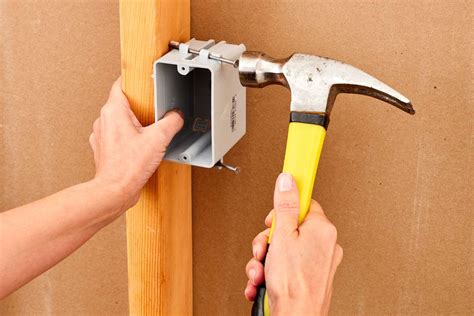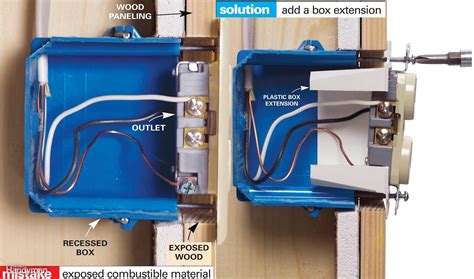electrical box depth drywall Follow these expert tips to install an electrical box into drywall or plaster without the need for wall studs or joists. Not all fixtures need to be attached to a wall stud or joist. . To weld thin metal, choose an appropriate process (TIG or MIG with low amperage), use a smaller diameter wire or filler rod, and adjust travel speed to prevent burn-through. Employ a pulsing technique, stitch welding, or tack welds to manage heat and allow cooling periods between welds to minimize warping.
0 · putting electrical box existing drywall
1 · installing wall mounted electrical boxes
2 · installing electrical box on drywall
3 · electrical outlet boxes for drywall
4 · electrical box for existing wall
5 · electrical box for existing drywall
6 · drywall mounted electrical box wings
7 · drywall mounted electrical box
Wellington Sheet Metal Ltd. We offer complete mechanical installations, service and maintenance for Commercial, Industrial, Institutional, and Multi Residential clients. We provide our services and expertise to property management companies, school boards, developers, commercial property owners, and general contractors.
putting electrical box existing drywall
Installing electrical boxes the depth of drywall while studs and joists are exposed is a handy and simple solution for homeowners. To do this on your own, buy switch and receptacle boxes that meet local codes and are large enough for the wires they hold.Follow these expert tips to install an electrical box into drywall or plaster .
installing wall mounted electrical boxes
My issue is that I need to install new work boxes so that they extend 1 1/4" beyond the stud. This way, when my second layer of 5/8" drywall goes up, it will be flush. I don't have enough depth with the boxes I am using to go out 1 1/4", .
When you install an electrical box, make sure it is flush with the surface of this drywall strip; this will ensure the boxes are at the proper depth when the walls are finished. .
Follow these expert tips to install an electrical box into drywall or plaster without the need for wall studs or joists. Not all fixtures need to be attached to a wall stud or joist. .
One thing to consider as far as determining the proper depth of electrical boxes is whether additional material will be applied on top of the drywall. For instance, decorative tile, adhesive faux tile panels, and similar wall coverings will add .
Safely and effectively install an electrical box in drywall by following step-by-step guidelines, ensuring proper placement, secure installation, and thorough testing for a successful DIY electrical project. Cut-in electrical boxes secure into the drywall or plaster using wing screws or Madison straps, depending on the type of box you have. The wings press against the drywall and hold the box firmly in place. Likewise, .
I've got a bit of a dilemma with walls that are thicker than what the original electrical layout allowed for. All of the boxes (switches, light fixtures, outlets, etc.) are anchored to studs and/or rafters and set at a depth that .
installing electrical box on drywall
A single-gang box 3 1⁄2 in. deep has a capacity of roughly 22 1⁄2 cu. in., enough space for a single device (receptacle or switch), three 12–2 w/grd cables, and two wire connectors. Double-gang boxes hold two devices; triple-gang boxes hold . Installing electrical boxes the depth of drywall while studs and joists are exposed is a handy and simple solution for homeowners. To do this on your own, buy switch and receptacle boxes that meet local codes and are large enough for the wires they hold.My issue is that I need to install new work boxes so that they extend 1 1/4" beyond the stud. This way, when my second layer of 5/8" drywall goes up, it will be flush. I don't have enough depth with the boxes I am using to go out 1 1/4", so I am wondering if I can extend it 1 1/8" instead. Installing an electrical box at the proper depth of drywall involves several steps, including determining the location of the box, marking the outline on the drywall, cutting out the opening, measuring and cutting the hole in the framing, inserting and securing the box, connecting the electrical wiring, and finally, installing the wall plate .

When you install an electrical box, make sure it is flush with the surface of this drywall strip; this will ensure the boxes are at the proper depth when the walls are finished. Most residential drywall is 1/2- or 3/8-inch thick, so keep a handful of drywall strips of this thickness on hand to facilitate electrical box installation. Follow these expert tips to install an electrical box into drywall or plaster without the need for wall studs or joists. Not all fixtures need to be attached to a wall stud or joist. Lightweight fixtures can hold up on plaster or drywall if you have a remodel electrical box.One thing to consider as far as determining the proper depth of electrical boxes is whether additional material will be applied on top of the drywall. For instance, decorative tile, adhesive faux tile panels, and similar wall coverings will add additional thickness to the underlying drywall.
Safely and effectively install an electrical box in drywall by following step-by-step guidelines, ensuring proper placement, secure installation, and thorough testing for a successful DIY electrical project.
Cut-in electrical boxes secure into the drywall or plaster using wing screws or Madison straps, depending on the type of box you have. The wings press against the drywall and hold the box firmly in place. Likewise, Madison straps secure the box by grabbing on behind the drywall to support the box.
I've got a bit of a dilemma with walls that are thicker than what the original electrical layout allowed for. All of the boxes (switches, light fixtures, outlets, etc.) are anchored to studs and/or rafters and set at a depth that would be fitting for some thin paneling or drywall.A single-gang box 3 1⁄2 in. deep has a capacity of roughly 22 1⁄2 cu. in., enough space for a single device (receptacle or switch), three 12–2 w/grd cables, and two wire connectors. Double-gang boxes hold two devices; triple-gang boxes hold three devices. Installing electrical boxes the depth of drywall while studs and joists are exposed is a handy and simple solution for homeowners. To do this on your own, buy switch and receptacle boxes that meet local codes and are large enough for the wires they hold.My issue is that I need to install new work boxes so that they extend 1 1/4" beyond the stud. This way, when my second layer of 5/8" drywall goes up, it will be flush. I don't have enough depth with the boxes I am using to go out 1 1/4", so I am wondering if I can extend it 1 1/8" instead.
Installing an electrical box at the proper depth of drywall involves several steps, including determining the location of the box, marking the outline on the drywall, cutting out the opening, measuring and cutting the hole in the framing, inserting and securing the box, connecting the electrical wiring, and finally, installing the wall plate . When you install an electrical box, make sure it is flush with the surface of this drywall strip; this will ensure the boxes are at the proper depth when the walls are finished. Most residential drywall is 1/2- or 3/8-inch thick, so keep a handful of drywall strips of this thickness on hand to facilitate electrical box installation.
Follow these expert tips to install an electrical box into drywall or plaster without the need for wall studs or joists. Not all fixtures need to be attached to a wall stud or joist. Lightweight fixtures can hold up on plaster or drywall if you have a remodel electrical box.One thing to consider as far as determining the proper depth of electrical boxes is whether additional material will be applied on top of the drywall. For instance, decorative tile, adhesive faux tile panels, and similar wall coverings will add additional thickness to the underlying drywall. Safely and effectively install an electrical box in drywall by following step-by-step guidelines, ensuring proper placement, secure installation, and thorough testing for a successful DIY electrical project. Cut-in electrical boxes secure into the drywall or plaster using wing screws or Madison straps, depending on the type of box you have. The wings press against the drywall and hold the box firmly in place. Likewise, Madison straps secure the box by grabbing on behind the drywall to support the box.
sheet metal weld test
I've got a bit of a dilemma with walls that are thicker than what the original electrical layout allowed for. All of the boxes (switches, light fixtures, outlets, etc.) are anchored to studs and/or rafters and set at a depth that would be fitting for some thin paneling or drywall.

electrical outlet boxes for drywall
electrical box for existing wall
electrical box for existing drywall
WMT can offer Entry-Level solutions from 3 + 2 or 4 + 1, to full 5-axis simultaneous machines, and the machines are available with a choice of controls too (including Siemens, Heidenhain and Fanuc).
electrical box depth drywall|installing electrical box on drywall